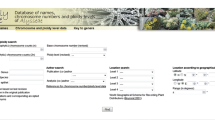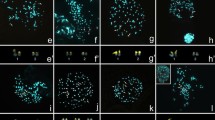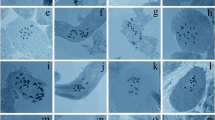Abstract
First generic chromosome counts reveal the base number x=7 for the generaTetrameranthus andRollinia. T. umbellatus from the Peruvian Amazon is diploid (2n=14),T. duckei from Brazil (Manaus) is tetraploid (2n=28). In the NeotropicsRollinia (7 species counted) has developed diploid to octoploid taxa (2n=14, 28, 42, 56). Counts of 7 South AmericanAnnona species are presented for comparison (2n=14, 28). The West AfricanCleistopholis patens has 2n=14. The Asian genusMezettia: 2n=14 and the neotropicalGuatteria tribe: 2n=28 are also revised. A detailed karyomorphological comparison, including karyotypes, banding patterns, condensing behaviour of chromosomes and structure of interphase nuclei reveals that the closely related generaAnnona andRollinia are almost identical in their diploid genomes, whereas the polyploid ones differ in their heterochromatin (=hc) composition and number of NO-chromosomes.Cleistopholis, Mezettia and theGuatteria tribe are karyologically and systematically distinct from each other and fromAnnona/Rollinia. Tetrameranthus as compared with the karyomorphology of about 60 other Annonaceous genera has a very peculiar and unusual karyomorphology which underlines its isolated position. Nuclear structures are almost identical in the African genusUvariopsis (2n = 16) and partly similar in theGuatteria tribe; both also share some morphological similarities and possibly are related. From a comparison ofTetrameranthus with several nuclear types within theMagnoliidae, a new model of chromosome evolution in primitive Angiosperms is suggested. In respect to their eco-morphological differentiation the genera investigated differ strongly from each other.
Similar content being viewed by others
References
Bowden, W. M., 1948: Chromosome numbers in theAnnonaceae. — Amer. J. Bot.35, 377–382.
Deumling, B., Greilhuber, G., 1982: Characterization of heterochromatin in different species of theScilla siberica group (Liliaceae) by in situ hybridization of satellite DNAs and fluorochrome banding. — Chromosoma (Berl.)84, 535–555.
Ehrendorfer, F., 1982: Speciation patterns in woody Angiosperms of tropical origin. — InBarigozzi, C., (Ed.): Mechanisms of speciation, 479–509. — New York: Liss.
, 1983: Quantitative and qualitative differentiation of nuclear DNA in relation to plant systematics and evolution. — InJensen, U., Fairbrothers, D. E., (Eds.): Proteins and Nucleic Acids in Plant Systematics. — Berlin, Heidelberg: Springer.
, 1968: Chromosome numbers and evolution in primitive Angiosperms. — Taxon17, 337–468.
Endress, P. K., 1983: Dispersal and distribution in some small archaic relic Angiosperm families (Austrobaileyaceae, Eupomatiaceae, Himantandraceae, Idiospermoideae-Calycanthaceae). — InKubitzki, K., (Ed.): Dispersal and distribution. An International Symposium. — Sonderb. Naturwiss. Ver. Hamburg7, 201–207.
Engler, A., Diels, L., 1901:Anonaceae. — InEngler, A., (Ed.): Monographieen afrikanischer Pflanzen-familien und -gattungen. — Leipzig: W. Engelmann.
Fries, R. E., 1931: Revision der Arten einiger Annonaceen-Gattungen. — Acta Hort. Berg.10, 1–341.
Fries, R. E., 1939: Revision der Arten einiger Annonaceen-Gattungen. — Acta Hort. Berg.12, 1–577.
, 1959:Annonaceae. — InEngler, A., Prantl, K., (Eds.): Die natürlichen Pflanzenfamilien, ed. 2,17 aII. — Berlin: Duncker & Humblot.
Gottsberger, G., 1970: Beiträge zur Biologie von Annonaceen-Blüten. — Österr. Bot. Z.118, 237–279.
Guerra, M., 1980: Karyosystematik und Evolution derRutaceae. — Diss. Formal Naturw. Fak. Univ. Wien.
, 1983: O uso de Giemsa na citogenética vegetal — comparação entre a coloração simples e o bandeamento. — Ciência e Cultura35, 190–193.
, 1984: Cytogenetics ofRutaceae. II. Nuclear DNA content. — Caryologia37, 219–226.
Greilhuber, J., Deumling, B., Speta, F., 1981: Evolutionary aspects of chromosome banding, heterochromatin, satellite DNA, and genome size inScilla (Liliaceae). — Ber. Deutsch. Bot. Ges.94, 249–266.
, 1984: Chromosomal evidence in taxonomy. — InHeywood, V. H., Moore, D. M., (Eds.): Current Concepts in Plant Taxonomy. — Systematics Association Special Volume No.25, 157–180. — London and Orlando: Academic Press.
Hallé, F., Oldeman, R. A. A., Tomlinson, P. B., 1978: Tropical Trees and Forests. An Architectural Analysis. — Berlin, Heidelberg, New York: Springer.
Heitz, E., 1933: Die Herkunft der Chromocentren. Dritter Beitrag zur Kenntnis der Beziehung zwischen Kernstruktur und qualitativer Verschiedenheit der Chromosomen in ihrer Längsrichtung. — Planta18, 571–636.
, 1935: Chromosomenstruktur und Gene. — Z. ind. Abstammungs- und Vererbungslehre.70, 402–447.
Hesse, M., Waha, M., 1984: Sporoderm characters ofTetrameranthus duckei (Annonaceae) and their systematic implications. — Pl. Syst. Evol.147, 323–326.
, 1985: Pollen ultrastructure and systematic affinities ofAnaxagorea (Annonaceae). — Pl. Syst. Evol.148, 253–285.
Le Thomas, A., 1969: Annonacées. — In:Aubréville, A., (Ed.): Flore du Gabon. — Paris: Muséum National d'Histoire Naturelle.
, 1981: Ultrastructural characters of pollen grains of AfricanAnnonaceae and their significance for the phylogeny of primitive Angiosperms. — Pollen & Spores22, 265–342, and23, 5–36.
Levin, D. A., Funderburg, S. W., 1979: Genome size in Angiosperms: temperate versus tropical species. — Amer. Nat.114, 784–795.
Lisboa, P. L., 1975: Estudos sobre a vegetação das Campinas Amazonicas. II. — Acta Amazonica5, 211–223.
Loidl, J., 1981: Das Heterochromatin einigerAllium-Arten: Cytochemische Charakterisierung und cytogenetische Aspekte. — Diss. Form. Naturw. Fak. Univ. Wien.
Maas, P. J. M., Westra, L. Y. Th., (Eds.), 1984: Studies inAnnonaceae. II. A monograph of the genusAnaxagorea A.St. Hil. (Annonaceae). — Bot. Jahrb. Syst.105, 73–134.
Macedo, M., 1977: Dispersão de plantas lenhosas de uma Campina Amazonica. — Acta Amazonica7 (Suppl.), 5–69.
Mangenot, S., Mangenot, G., 1962: Enquête sur les nombres chromosomiques dans une collection d'espèces tropicales. — Rev. Cyt. Biol. Veg.25, 411–447.
Morawetz, W., 1981a: Karyologie und ökologisch-morphologische Differenzierung vonPeumus boldus (Monimiaceae—Laurales). — Pl. Syst. Evol.138, 157–173.
Morawetz, W., 1981b: C-banding inLiriodendron tulipifera (Magnoliaceae): Some karyological and systematic implications. — Pl. Syst. Evol.138, 209–216.
, 1984a: How stable are genomes of tropical woody plants? Heterozygosity of C-banded karyotypes ofProcelia as compared withAnnona (Annonaceae) andDrimys (Winteraceae). — Pl. Syst. Evol.145, 29–39.
, 1984b: Karyological races and ecology ofDuguetia furfuraceae as compared withXylopia aromatica (Annonaceae). — Flora175, 195–209.
, 1984c: Karyologie, Ökologie und Evolution der GattungAnnona in Pernambuco, Brasilien. — Flora175, 335–347.
, 1985: Beiträge zur Karyologie und Systematik der GattungThottea (Aristolochiaceae). — Bot. Jahrb. Syst.107, 329–342.
, 1986a: Remarks on karyological differentiation patterns in tropical woody plants. — Pl. Syst. Evol.152, 49–100.
- 1986b: Karyosystematics and evolution of AustralianAnnonaceae, as compared withEupomatiaceae, Himantandraceae andAustrobaileyaceae. — Pl. Syst. Evol. (in press).
, 1984: Notes on the systematics of the Amazonian genusGuatteriella (Annonaceae). — Pl. Syst. Evol.148, 19–23.
, 1985: A new pollen type, C-banded and fluorescent counterstained chromosomes and evolution inGuatteria and related genera (Annonaceae). — Pl. Syst. Evol.150, 119–141.
Okada, H., 1975: Karyomorphological studies of woodyPolycarpicae. — J. Sci. Hiroshima Univ. Ser. B Div. 2, Bot.15, 115–200.
, 1984: Cytotaxonomical studies on AsianAnnonaceae. — Pl. Syst. Evol.144, 165–177.
Ray, J., Venketesvaran, S., 1978: Constitutive heterochromatin distribution in monocentric and polycentric chromosomes. — Chromosoma (Berl.)66, 341–350.
Rüdenberg, L., 1967: The chromosomes ofAustrobaileya. — J. Arn. Arbor.48, 241–244.
Sauer, W., Ehrendorfer, F., 1970: Chromosomen, Verwandtschaft und Evolution tropischer Holzpflanzen, II.Himantandraceae. — Österr. Bot. Z.118, 38–54.
, 1984: Notes on the karyosystematics ofAnnonaceae. — Pl. Syst. Evol.146, 47–55.
Schwarzacher, G., Ambros, P., Schweizer, D., 1980: Application of Giemsa banding to Orchid karyotype analysis. — Pl. Syst. Evol.134, 293–297.
, 1982: Karyotype analysis and heterochromatin differentiation with Giemsa C-banding and fluorescent counterstaining inCephalanthera (Orchidaceae). — Pl. Syst. Evol.134, 293–297.
Schweizer, D., 1976: Reverse fluorescent chromosome banding with Chromomycin and DAPI. — Chromosoma (Berlin)58, 307–324.
, 1980: Fluorescent chromosome banding in plants: applications, mechanisms, and implications for chromosome structure. — InDavies, D. R., Hopwood, R. A., (Eds.): The Plant Genome. Proc. 4th John Innes Symp, 61–72. — John Innes Charity, Norwich.
, 1981: Counterstain-enhanced chromosome banding. — Hum. Genet.57, 1–14.
, 1983: Evolution of C-band patterns inAsteraceae — Anthemideae. — Biol. Zbl.102, 637–655.
Stone, D. E., Freeman, J. L., 1968: Cytotaxonomy ofIllicium floridanum andI. parviflorum (Illiciaceae). — J. Arn. Arbor.49, 41–51.
Tanaka, R., Okada, H., 1972: Karyological studies in four species ofAnnonaceae, a primitive Angiosperm. — J. Sci. Hirosh. Univ. ser. V, div. 2 (Bot.)14 (2), 85–105.
Tschermak-Woess, E., 1963: Strukturtypen der Ruhekerne von Pflanzen und Tieren. — Wien: Springer.
Waha, M., Morawetz, W., 1987: Pollen evolution and systematics inAnnonaceae with special reference to the disulcate Australian endemic genera. — Pl. Syst. Evol. (in press).
Walker, J. W., 1971: Pollen morphology, phytogeography and phylogeny of theAnnonaceae. — Contr. Gray. Herb.202, 3–131.
Webber, A., 1981: Biologia floral de algumasAnnonaceae na região de ManausAm. — Thesis, Instituto Nacional de Pesquisas da Amazonia and Fundação Universidade do Amazonas, 81 pp.
Westra, L. Y. Th., 1985: Studies inAnnonaceae. IV. A taxonomic revision ofTetrameranthus R. E. Fr. — Proc. Kon. Ned. Wet., series C88, 449–482.
Author information
Authors and Affiliations
Additional information
Dedicated to Prof. Dr. K.-H.Rechinger on the occasion of His 80th birthday.
Rights and permissions
About this article
Cite this article
Morawetz, W. Systematics and karyoevolution inMagnoliidae:Tetrameranthus as compared with otherAnnonaceae genera of the same chromosome number. Pl Syst Evol 154, 147–173 (1986). https://doi.org/10.1007/BF00984875
Received:
Issue Date:
DOI: https://doi.org/10.1007/BF00984875




